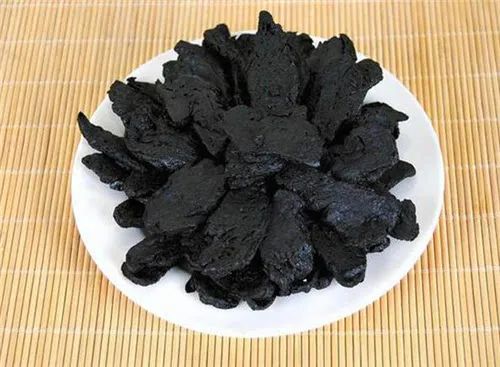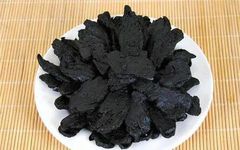
【Chinese Herbal Name】熟地黄 (Shu Di Huang)
【Alias】熟地 (Shu Di).
【English Name】Rehmanniae Radix Praeparata.
【Medicinal Part】The fresh tuber of the plant Rehmannia glutinosa (Libosch.) of the Scrophulariaceae family, processed by steaming and drying.
【Plant Morphology】A perennial herb, 10 to 70 cm tall. The entire plant is covered with grayish-white long soft hairs and glandular hairs. The roots are thick, fleshy, tuberous, cylindrical, or spindle-shaped. The stem is erect, single or branched at the base. The basal leaves are clustered, with ovate-lanceolate leaf blades, blunt tips, gradually narrowing at the base, extending into long petioles, with a wrinkled surface and irregular serrated edges; stem leaves are smaller. The flower stalk is erect, hairy, and forms a racemose inflorescence at the upper part of the stem; bracts are leaf-like, well-developed or degenerated; the calyx is bell-shaped, with 5 lobes at the tip, triangular lobes covered with long soft hairs and white long hairs, with 10 veins; the corolla is wide tubular, slightly curved, dark purple outside, mixed with yellow inside, with distinct purple stripes, 5 shallow lobes at the tip, slightly bilabiate; there are 4 stamens, two of which are strong, with the anther base forked; the ovary is superior, oval, 2-celled, becoming 1-celled after flowering, with 1 style and a swollen stigma. The capsule is oval or long oval, pointed at the tip, with a persistent style, surrounded by the persistent calyx. The seeds are numerous. Flowering period is from April to May, fruiting period is from May to June.
【Distribution】Produced in most regions of the country, with high yield and quality in Wenxian, Boai, and Mengxian in Henan Province.
【Harvesting and Processing】(1) For fresh Rehmannia, use the wine-steaming method until the wine is absorbed, then take it out, dry until the surface mucilage is slightly dry, cut into thick slices or blocks, and dry to obtain. For every 100 kg of fresh Rehmannia, use 20-30 kg of yellow wine. (Wine-steaming method: Take the raw material according to the regulations for each variety, add wine, place in a suitable container, seal, and heat with water or steam until thoroughly cooked, or until the wine is completely absorbed, cool, take out, dry until 60% dry, cut into slices, and dry.)
(2) For fresh Rehmannia, steam until black and shiny, take out, dry until about 80% dry, cut into thick slices or blocks, and dry to obtain. (Steaming method: Take the raw material, sort by size, mix with water or liquid auxiliary materials, place in a suitable steaming container, heat with steam to the specified degree, take out, cool slightly, mix back with the steaming liquid, dry until 60% dry, cut into slices or sections, and dry.)
【Material Characteristics】The product appears as irregular blocks or fragments, varying in size and thickness. The surface is black with luster and has high viscosity. The texture is soft yet tough, not easily broken, with a black and shiny cross-section. It has a faint odor and a sweet taste.
【Properties and Channels】Slightly warm in nature, sweet in taste. It enters the Liver and Kidney meridians.
【Functions and Indications】Nourishes blood and enriches yin, benefits essence and fills marrow. It is classified as a blood tonic under the category of tonifying herbs.
【Clinical Applications】For internal use: dosage of 10-30 grams, or in pills, powders, or decoctions, or soaked in wine. Used for blood deficiency with sallow complexion, palpitations, irregular menstruation, excessive bleeding, Liver and Kidney yin deficiency, soreness of the lower back and knees, bone steaming heat, night sweats, seminal emission, internal heat with thirst, dizziness, tinnitus, and premature graying of hair.
【Pharmacological Research】Comparative studies on the effects of cooked and raw Rehmannia on vascular thrombosis indicate that the coarse cooked Rehmannia from China can strongly inhibit hepatic hemorrhagic necrosis and simple necrosis. The anticoagulant effect of cooked Rehmannia is weaker. Using the fibrin plate method to explore the activation of the fibrinolytic system, it was found that cooked Rehmannia has an activating effect, while raw Rehmannia does not. Reports also suggest that both cooked and raw Rehmannia have hemostatic effects, and the hemostatic effect of carbonized Rehmannia is not enhanced. Analysis of the hemostatic effects of decoctions from raw Rehmannia, cooked Rehmannia, carbonized raw Rehmannia, and carbonized cooked Rehmannia showed no significant differences.
【Chemical Composition】The water and alcohol extracts of various cooked Rehmannia are higher than those of raw and dried Rehmannia, but the differences among various processing methods are not significant. Unique cyclic ether terpenes and glycosides are found in dried Rehmannia, while cooked Rehmannia contains almost none. Cooked Rehmannia contains 8.57% glucose, which is higher than the content in fresh Rehmannia (1.56%), indicating that some polysaccharides are converted to monosaccharides during processing. During the processing of dried and cooked Rehmannia, glycoside components also undergo varying degrees of decomposition, with monosaccharide glycosides decomposing the most, followed by disaccharide glycosides, while the trioside Rehmannioside D (Rehmannioside D) is almost not decomposed. The differences between cooked and dried Rehmannia are not significant except for the decomposition of catalpol in cooked Rehmannia.
【Contraindications】Contraindicated in cases of spleen and stomach deficiency, qi stagnation with phlegm, abdominal fullness, and loose stools.
【Compatible Formulas】① For treating impotence: 30 grams of cooked Rehmannia, 12 grams each of Shan Yao (Chinese Yam), Bai Zhu (White Atractylodes), 3 grams each of Yuan Zhi (Polygala), Ba Jiao Tian (Morinda), and Du Zhong (Eucommia), 6 grams each of Rou Gui (Cinnamon) and Fu Shen (Poria), 9 grams each of Ren Shen (Ginseng) and Gou Qi Zi (Goji Berries), 15 grams each of She Chuang Zi (Cynomorium) and Rou Cong Rong (Cistanche), 10 grams of Huang Qi (Astragalus), and 20 grams each of Da Bao (Placenta) powder and Xian Ling Pi (Epimedium) (swallowed). For chronic cases (impotence lasting over 3 years), add 1.5 grams of Lu Rong (Deer Antler) powder (dissolved) or 10 grams of Lu Jiao Jiao (Deer Antler Glue) (melted and dissolved), with a treatment course of 10 days. Rest for 1 week, then continue with the second course. [“Shanxi TCM”, 1990; 6(3): 16]
② For treating elderly constipation: 30 grams each of cooked Rehmannia, Dang Gui (Angelica), Wei Ling Xian (Clematis), Bai Zhu (Atractylodes), and He Shou Wu (Fo-Ti), and 10 grams of Sheng Ma (Cimicifuga). Decoction for 1 dose per day. [“Inner Mongolia TCM”, 1991; (3): 15]
③ For treating alopecia areata: 60 grams each of cooked Rehmannia and Tu Si Zi (Cuscuta), 30 grams each of Dang Gui (Angelica), Chuan Xiong (Ligusticum), and Hang Shao (Peony), and 24 grams each of Mu Guo (Papaya), Tian Ma (Gastrodia), and Qiang Huo (Notopterygium), ground into a fine powder, mixed with 586 grams of honey to form pills, with a dosage of 10 grams taken twice daily. Additionally, use external wash medicine for treating alopecia areata, with good efficacy. [“Journal of Traditional Chinese Medicine”, 1963; (7): 14]

Copyright belongs to the original author. If there is any infringement, please contact us promptly, and we will delete it immediately. Thank you.


